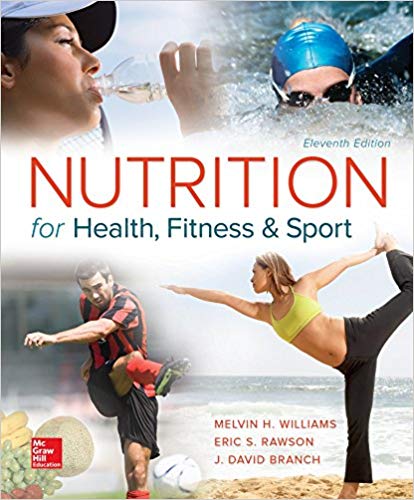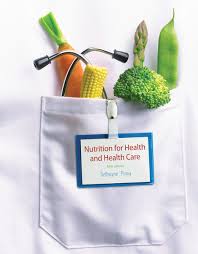Description
Test Bank For Nutrition for Health, Fitness and Sport 11th Edition by Melvin Williams
Chapter 03 Test Bank
Student:
1. Work may be expressed as foot-pounds, kilogram–meters, and joules. In essence then, to measure work one needs to know the weight of an object and the
A. horizontal distance through which it moved. B. vertical distance through which it moved.
C. time it took to move it.
D. horizontal distance through which it moved and the time it took to move it.
2. The immediate source of energy for all body processes, including muscle contraction, is
A. muscle glycogen.
B. adenosine triphosphate. C. phosphocreatine.
D. both ATP and PC.
3. One gram of fat yields Calories.
A. 4
B. 5
C. 7
D. 9
4. Which of the following sport events would rely on the lactic acid system for most of the energy production?
A. Competitive weight lifting
B. The 100 meter dash C. The 800 meter run D. A 5 kilometer run
5. The oxygen system
A. produces ATP in rather large quantities from other energy sources in the body.
B. involves aerobic processing of carbohydrates to some extent, with major utilization of protein. C. is used primarily in sports that demand strenuous exercise.
D. depends upon reactions that occur in the nucleus of the cell.
6. Which of the following is an example of catabolism?
A. Increased muscle mass gained through weight training
B. Constructive metabolism
C. The changing of muscle glycogen to muscle glucose
D. The better use of oxygen following endurance training
7. The elevation of the metabolic rate that occurs after ingestion of a meal is
A. increased significantly by the ingestion of fat.
B. accountable for less than 3 percent of the total daily energy expenditure. C. referred to as dietary-induced thermogenesis or thermic effect of food. D. significantly higher in obese subjects when compared to lean subjects.
8. The resting energy expenditure is
A. increased when the ratio of body surface area to body weight is decreased. B. higher during adolescence than during adulthood.
C. decreased when an individual is exposed to the cold.
D. 25 percent lower for a female when compared to that of a male.
9. All of the following are laboratory techniques used to measure the role of the lactic acid system in exercise EXCEPT
A. the anaerobic threshold.
B. the steady-state threshold. C. maximal oxygen uptake. D. onset of blood lactic acid.
10. Which of the following statements about energy expenditure is INCORRECT?
A. The cost of running a given distance does not depend on the speed of movement
B. Hand weights seem to increase energy expenditure only when used at slower speeds
C. Swimming a given distance takes about four times as much energy as running that distance
D. The use of hand weights may exaggerate the blood pressure response
11. Studies investigating the metabolic aftereffects of exercise indicate that
A.exercise will keep the REE elevated during the recovery period at levels 20 to 25 percent higher than the pre–exercise REE.
B.hormones will influence metabolic processes in such a way that circulation and respiration will remain elevated for 6-8 hours.
C. the effect is dependent on the intensity and duration of the exercise bout.
D. the additional energy expenditure ranged from 50–100 Calories.
12. Your total daily energy expenditure is the sum of your
A. BMR, REE, and TEF. B. BMR, EMR, and TEF. C. REE, RMR, and TEE. D. REE, TEF, and TEE.
13. Which of the following exercises would be the energy equivalent of jogging one mile?
A. Bicycling 3 miles
B. Leisurely walking 3 miles
C. Swimming 1/3 miles
D. In–line skating one mile at the same pace as jogging
14. The Caloric expenditure of running one mile is approximately Calories per pound of bodyweight.
A. 0.55
B. 0.64
C. 0.73
D. 0.82
15. A type I muscle fiber
A. is called a slow-twitch red fiber.
B. can produce energy primarily by anaerobic processes. C. is also referred to as FOG.
D. All of these statements apply to type I muscle fibers.
16. Type IIa muscle fibers
A. are known as fast-twitch red fibers.
B. can produce energy by aerobic processes only.
C. can produce energy by the lactic acid system only. D. are also referred to as FG.
17. Type IIb muscle fibers
A. are also known as fast-twitch red fibers.
B. produce energy primarily by anaerobic processes.
C. use the ATP–PC system at a slower rate than Type I. D. are also referred to as FOG.
18. The main energy source for the lactic acid system during exercise is
A. protein.
B. phosphocreatine. C. carbohydrates.
D. triglycerides.
19. The main energy source for the oxygen system during exercise of 2 hours in length would be
A. glycogen found in the muscle, liver, and blood. B. triglycerides.
C. carbohydrates.
D. protein.
20. As you perform mild to moderate exercise (up to 50 percent of your VO2 max), you will use
A. only carbohydrate energy sources.
B. blood glucose and fat.
C. 80 percent carbohydrate energy sources. D. 95 percent carbohydrate energy sources.
21. During a ten minute period of maximal work, the contribution of the aerobic energy system to the total energy need would be
A. 95 percent. B. 85 percent. C. 70 percent. D. 50 percent.
22. On a mixed diet of carbohydrate, protein, and fat, what percent of the energy expenditure at rest is derived from fat?
A. 60 percent B. 50 percent C. 40 percent D. 30 percent
23. Which one of the following statements about fatigue is true?
A. Fatigue may only be physiological in nature
B. The site of fatigue is classified solely in the central nervous system
C. Fatigue is always due to an insufficient supply of the optimal energy source
D. The most important factor in the prevention of fatigue during exercise is training
24. When participating in very mild aerobic activities, which of the following will lead to fatigue in very prolonged bouts?
A. Diminishing carbohydrate levels. B. Low blood–sugar levels.
C. Low stores of fat.
D. All of these answers will lead to fatigue.
25. In very high–intensity exercise, lasting only one or two minutes, the probable cause of fatigue is
A. a depletion of phosphocreatine.
B. a depletion of carbohydrate stores. C. loss of lipid reserves.
D. disruption of cellular metabolism caused by the accumulation of hydrogen ions.
26. One liter of oxygen is the equivalent of approximately how many Calories when oxidizing carbohydrate and fat?
A. 2
B. 5
C. 8
D. 12
27. Approximately how many Calories will a 150–pound individual use while jogging a mile?
A. 70
B. 110
C. 145
D. 200
E. 250
28. If a 70-kilogram body weight athlete was exercising at an oxygen consumption level of 2.94 liters
(2,940ml) per minute, what would be the approximate MET level? A. 8
B. 10
C. 11
D. 12
E. 14
29. If you exercise at an intensity of 1 liter of oxygen per minute, about how many Calories would you burn in one hour?
A. 50
B. 100
C. 300
D. 700
E. 1,000
30. Which energy system would predominate in an all–out, high–intensity, 100–meter dash in track?
A. ATP–PC (phosphagen)
B. Lactic acid (anaerobic glycolysis) C. Aerobic glycolysis
D. Aerobic lipolysis
E. Aerobic proteolysis
31. Which of the following classifications of physical activity is rated as light, mild aerobic exercise because it is likely to burn less than 5 Calories per minute?
A. competitive racquetball
B. running at a speed of 7 miles per hour
C. walking at a speed of 2.0 miles per hour
D. competitive singles tennis
E. bicycling at a speed of 18 miles per hour
32. In the average sedentary individual, approximately what percentage of the total daily energy expenditure
(TDEE) is determined by the basal energy expenditure (BEE)? A. less than 10
B. 10–20
C. 30–40
D. 40–50
E. greater than 50
33. Which of the following energy sources found in the human body represents the LOWEST storage of potential energy in the form of total Calories?
A. muscle protein
B. liver glycogen
C. muscle glycogen
D. adipose tissue triglycerides
E. blood glucose





Be the first to review “Test Bank For Nutrition for Health, Fitness and Sport 11th Edition by Melvin Williams”